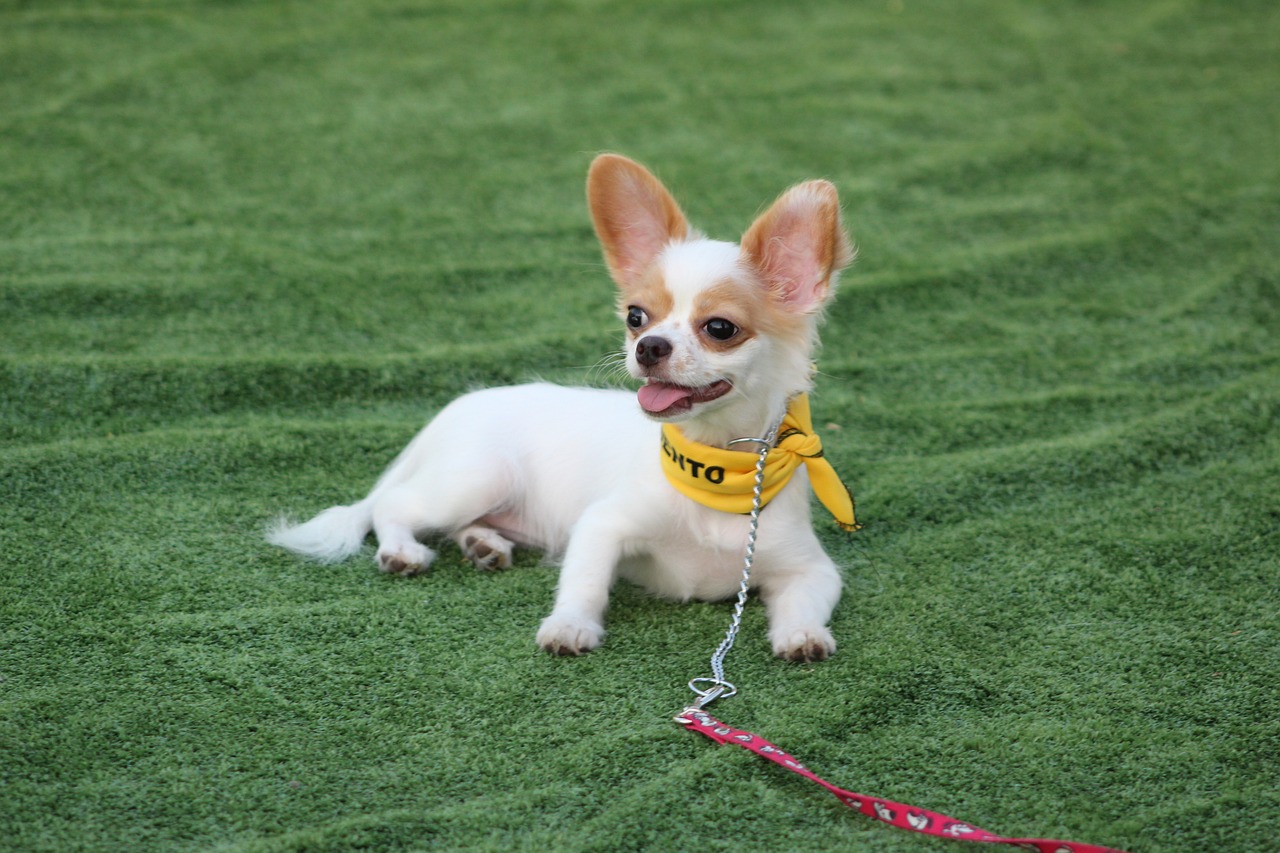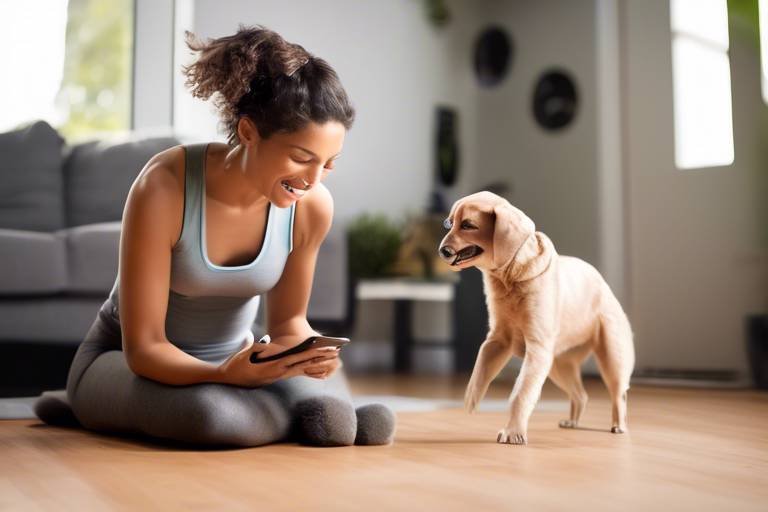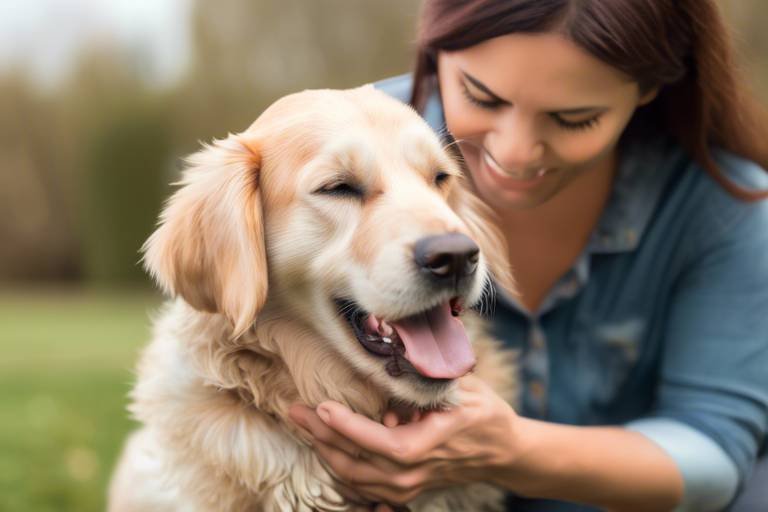The Benefits of In-Home Training for Pets
In today's fast-paced world, pet owners are constantly seeking ways to enhance their furry friends' lives while juggling their own busy schedules. One of the most effective and rewarding methods is in-home training. This approach not only ensures that your pet receives the best possible education but also strengthens the bond between you and your beloved companion. So, what are the key advantages of training your pet at home? Let’s dive into the numerous benefits that in-home training can offer, from convenience to personalized attention, and discover how it can lead to a happier, well-behaved pet.
Imagine this: you come home after a long day, and instead of rushing to a training class, you can simply set up a training session right in your living room. In-home training provides an unparalleled level of convenience that traditional classes simply cannot match. Your pet gets to learn in a familiar environment, which significantly reduces stress and anxiety. When pets feel comfortable, they are more likely to engage and absorb the training effectively. This familiarity creates a relaxed atmosphere where learning can thrive, ensuring your pet is receptive and eager to participate in the training sessions.
Every pet is unique, with its own personality, quirks, and learning pace. In-home training allows for customized training plans that are tailored specifically to your pet's needs. This personalized approach means that trainers can focus on specific behaviors and challenges that your pet faces, leading to more effective learning and quicker results. For instance, if your dog struggles with leash manners, a trainer can design a plan that focuses exclusively on that issue, ensuring that your pet receives the attention and guidance it needs to improve.
One of the standout benefits of in-home training is its effectiveness in addressing specific behavioral problems. Trainers can observe pets in their natural environment, which allows them to identify triggers and patterns that may not be apparent in a classroom setting. This firsthand observation leads to targeted strategies that can correct unwanted behaviors. Whether your pet has issues with barking, chewing, or anxiety, in-home training provides the tools and techniques necessary to foster positive changes.
Another advantage of training at home is the opportunity for socialization with family members and other pets. This gradual introduction to various social situations can help build your pet's confidence. For example, when your dog interacts with your children during training, it learns to adapt to different personalities and behaviors, which can lead to better interactions with strangers and other animals in the future. By incorporating family members into the training process, you create a well-rounded social experience for your pet.
In-home training fosters a stronger bond between pet and owner. The personalized attention and consistent interaction create a trusting relationship, enhancing overall communication and understanding. When pets see their owners actively involved in their training, they feel more secure and connected. This bond is crucial for effective training, as pets are more likely to respond positively to commands and cues from someone they trust.
Life can be unpredictable, and finding time for training can often feel like a challenge. In-home training offers the flexibility to schedule sessions that fit your lifestyle. Whether you prefer early morning sessions or late evening classes, you can choose the times that work best for both you and your pet. This convenience ensures that training can occur at optimal moments, allowing for better focus and retention of skills.
Cost is always a consideration for pet owners, and in-home training can be more cost-effective than traditional classes. By eliminating travel expenses and providing tailored sessions, owners can save money while still achieving effective training results. Plus, the personalized nature of in-home training often leads to faster results, meaning you won’t have to invest in as many sessions as you might with a group class.
The skills learned during in-home training can lead to long-lasting behavioral changes. Consistent reinforcement in a familiar environment helps ensure that pets retain their training over time. Unlike short-term fixes, the techniques learned through in-home training can become a natural part of your pet's behavior, leading to a more harmonious household.
Finally, in-home training promotes better communication between pets and owners. By understanding each other's cues and responses, both parties can improve the overall training experience. This enhanced communication leads to a more harmonious relationship where both pet and owner feel understood and respected. The result? A happier, more well-adjusted pet and a more enjoyable companionship.
- What is in-home training? In-home training involves a professional trainer coming to your home to work with you and your pet in a familiar environment.
- How does in-home training differ from traditional classes? In-home training is personalized and conducted in your pet's environment, while traditional classes are often held in group settings.
- Is in-home training suitable for all pets? Yes, in-home training can benefit pets of all ages and breeds, especially those with specific behavioral issues.
- How long does in-home training take? The duration varies based on the pet's needs, but many owners see improvements within a few sessions.

Convenience and Comfort
When it comes to training our furry friends, the environment plays a crucial role in how effectively they learn. In-home training offers a unique advantage by providing a comfortable and familiar setting for pets. Imagine trying to learn a new skill in a foreign place—distracting, right? This is how our pets feel when they are taken away from their cozy corners and transported to a training facility. By staying at home, pets can focus on their training without the added stress of unfamiliar surroundings.
In-home training significantly reduces stress and anxiety, which are common barriers to effective learning. Pets are naturally more relaxed when they are in their own space, surrounded by their favorite toys and scents. This comfort allows them to be more receptive to commands and new behaviors. For instance, a dog may feel anxious in a crowded class full of barking dogs, but in the comfort of their living room, they can learn to sit or stay with far less distraction.
Moreover, the convenience of in-home training cannot be overstated. Pet owners can schedule sessions at times that work best for them, ensuring that both the owner and pet are in the right mindset for learning. Whether it’s early morning or late evening, training can happen when it’s most convenient, making it easier to integrate into daily routines. This flexibility is particularly beneficial for busy families or individuals who juggle multiple responsibilities.
In-home training also allows for a more personalized approach. Trainers can observe pets in their natural habitat and tailor the training to fit their specific needs. For example, a trainer might notice that a dog is particularly responsive to treats when they are in the kitchen but less so in the living room. This insight allows for adjustments in the training plan that can lead to quicker and more effective results.
Additionally, in-home training fosters a sense of security for pets. They are less likely to feel overwhelmed or intimidated, which can happen in a group class setting. This sense of security encourages pets to engage more fully in the training process, leading to improved outcomes. The trainer can also incorporate elements of the home environment into the training, making it more relevant and practical for everyday life.
In summary, the convenience and comfort of in-home training not only help pets learn more effectively but also create a positive and stress-free atmosphere that enhances the overall training experience. With the right approach, both pets and their owners can enjoy a rewarding journey towards better behavior and deeper bonds.

Personalized Training Plans
When it comes to training our furry companions, one size definitely does not fit all. Just like humans, each pet has its own personality, strengths, and challenges. That's where come into play! Tailoring a training regimen specifically for your pet can make a world of difference in their learning journey. Instead of following a generic curriculum, in-home training allows for a focused approach that considers your pet's individual needs.
Imagine trying to learn a new skill in a crowded classroom where distractions are everywhere. Frustrating, right? Pets feel the same way! In a familiar environment, they can concentrate better and absorb new commands without the overwhelming stimuli of a traditional training setting. This personalized training not only enhances learning but also builds confidence in your pet. For instance, if your dog struggles with basic commands, a trainer can spend additional time on those specific areas, ensuring that your pet masters them before moving on to more complex tasks.
Furthermore, personalized training plans can adapt over time. As your pet progresses, trainers can adjust the curriculum to introduce new challenges or focus on areas that need improvement. This adaptability keeps the training engaging and effective, preventing boredom and frustration for both you and your pet. For example, if your dog excels at obedience but struggles with socialization, the trainer can incorporate socialization techniques into the sessions, addressing multiple aspects of your pet's development simultaneously.
Additionally, these plans provide an opportunity to address specific behavioral issues that may arise. Whether it’s excessive barking, chewing, or anxiety, trainers can observe your pet in their natural environment and devise targeted strategies to correct these unwanted behaviors. This hands-on approach not only helps in resolving issues but also teaches you how to manage these behaviors in real-time, reinforcing what your pet learns during training.
In summary, personalized training plans are the key to unlocking your pet's full potential. By focusing on their unique needs and creating a flexible, engaging curriculum, you can pave the way for a happier, more well-adjusted pet. So, why settle for cookie-cutter solutions when you can provide your furry friend with a training experience as unique as they are?
- What is personalized training? Personalized training refers to a customized approach to pet training that considers the individual needs, behaviors, and personality of each pet.
- How does in-home training differ from group classes? In-home training provides a tailored experience in a familiar environment, while group classes may not address specific behavioral issues or learning styles.
- Can personalized training help with behavioral issues? Absolutely! Personalized training allows trainers to focus on specific problems and develop targeted strategies to address them effectively.
- Is in-home training more expensive than group classes? While it may seem pricier initially, in-home training can save money in the long run by eliminating travel costs and providing more effective, focused sessions.
Addressing Behavioral Issues
When it comes to our furry friends, behavioral issues can sometimes feel like a daunting mountain to climb. But here’s the good news: in-home training is a powerful tool that can help tackle these challenges head-on. Imagine this scenario: your dog barks excessively at the mailman or your cat has taken a liking to scratching the furniture. These behaviors can be frustrating, but with the right approach, they can be corrected. In-home training allows trainers to observe pets in their natural environment, which is crucial for identifying the root causes of these behaviors.
One of the biggest advantages of in-home training is the ability to provide immediate feedback and tailored strategies. For instance, if your dog is anxious around strangers, a trainer can work with them in real-time, using techniques that are designed for that specific situation. This hands-on approach not only addresses the issue more effectively but also reduces the stress your pet might feel in unfamiliar environments, like a training facility.
Furthermore, in-home training can address a variety of behavioral issues, such as:
- Excessive barking: Trainers can identify triggers and teach your dog alternative behaviors.
- Separation anxiety: Personalized strategies can help your pet feel more secure when left alone.
- Destructive behavior: Tailored plans can redirect your pet's energy into more appropriate activities.
By focusing on your pet's unique needs, in-home training not only corrects unwanted behaviors but also builds a foundation of trust and understanding. This is especially important when dealing with issues that stem from fear or anxiety. A trainer can develop a gradual desensitization plan that helps your pet feel more comfortable in various situations, ultimately leading to a more confident and well-adjusted animal.
In conclusion, addressing behavioral issues through in-home training is not just about correcting unwanted actions; it’s about fostering a deeper connection between you and your pet. With personalized attention and strategies that cater to your pet's specific needs, you can create a harmonious living environment where both you and your furry friend can thrive.
Here are some common questions pet owners have about in-home training:
- What types of behavioral issues can in-home training address? In-home training can help with a wide range of issues, including barking, chewing, separation anxiety, and aggression.
- How long does it take to see results? The timeline can vary depending on the pet and the behavior being addressed, but many owners notice improvements within a few sessions.
- Is in-home training suitable for all pets? Yes! In-home training can be tailored to suit the needs of dogs, cats, and even other pets.
Socialization Opportunities
When it comes to training our furry friends, one of the most significant advantages of in-home training is the abundance of it provides. Unlike traditional training classes, which can often feel overwhelming for pets, in-home training allows for a more gradual and comfortable introduction to social interactions. Imagine your pet learning in a familiar environment, surrounded by family members and possibly other pets. This setting not only reduces anxiety but also promotes confidence, making it easier for them to engage positively with others.
During in-home training sessions, trainers can implement tailored socialization strategies that fit your pet's unique personality and needs. For example, if you have a shy dog, the trainer can introduce them slowly to family members or other pets in the household, allowing your dog to build trust at their own pace. As they become more comfortable, the trainer might suggest incorporating controlled interactions with friends or neighbors, further enhancing your pet's social skills.
Moreover, the personalized attention that in-home training offers means that trainers can observe your pet's reactions in real-time and adjust their approach accordingly. This flexibility is crucial because every pet has their own way of responding to social situations. For instance, some pets may thrive on playtime with other animals, while others might prefer more subdued interactions. By recognizing these preferences, trainers can create an effective socialization plan that fosters positive experiences.
Additionally, in-home training can include a variety of socialization activities, such as:
- Playdates with other pets
- Family gatherings where pets can meet new people
- Visits to pet-friendly locations
These experiences are not just about building social skills; they also contribute to a well-rounded and happy pet. A well-socialized pet is typically more adaptable, less anxious, and better equipped to handle new situations, whether it’s meeting a new friend or visiting a vet. Ultimately, in-home training provides a safe space for pets to learn and grow socially, making it a fantastic option for pet owners who want to ensure their companions are not only trained but also well-adjusted.
Q: How can I tell if my pet needs socialization training?
A: If your pet shows signs of anxiety, fear, or aggression towards new people or animals, they likely need socialization training. Look for behaviors such as barking, growling, or hiding when encountering new situations.
Q: Can in-home training help with my pet's socialization skills?
A: Absolutely! In-home training allows for personalized socialization opportunities tailored to your pet's unique needs, helping them become more comfortable and confident in various social settings.
Q: How long does it take to see results from socialization training?
A: The timeline can vary depending on the individual pet and their previous experiences. However, consistent training and exposure typically lead to noticeable improvements within a few weeks.
Q: Is in-home training suitable for all types of pets?
A: Yes! In-home training can benefit dogs, cats, and even other animals. The key is to find a trainer who understands the specific needs of your pet.
Building Trust and Bonding
In-home training is not just about teaching your pet commands or tricks; it’s a golden opportunity to build a deeper connection between you and your furry friend. Imagine this: you and your dog are in a cozy corner of your living room, surrounded by familiar scents and sounds. This environment is a safe space where your pet can truly be themselves. When pets feel secure, they are more likely to open up and engage in the training process. The result? A stronger bond that transcends mere obedience.
Trust is the foundation of any relationship, and in-home training fosters that trust effectively. As a pet owner, you’re not just another figure in their life; you become their trainer, their guide, and their best friend. The personalized attention you provide during these sessions shows your pet that you care about their well-being and happiness. This nurturing approach can lead to a significant transformation in behavior, as pets respond positively to the love and attention they receive. They start to see you as a reliable source of guidance, making them more eager to please you.
Additionally, in-home training allows for consistent interaction between you and your pet. Just like humans, pets thrive on routine and familiarity. When they know what to expect during training sessions, they feel more comfortable and less anxious. This comfort level encourages them to take risks, try new things, and engage more fully in the learning process. It's like building a bridge of trust; each training session strengthens that bridge, making it easier for them to cross over to a world of obedience and good behavior.
Moreover, incorporating fun activities into your training can enhance the bonding experience. For instance, you can use playtime as a reward for good behavior. This not only makes training enjoyable but also reinforces positive associations. When your pet associates training with fun, they are more likely to look forward to these sessions, further solidifying your bond. Think of it as a dance—when both partners are in sync, the performance is nothing short of spectacular!
In summary, in-home training is a powerful tool for with your pet. It creates an environment where they feel safe, encourages consistent interaction, and allows for personalized attention. By investing time and effort into this process, you’re not just training your pet; you’re forging a lifelong friendship that enriches both your lives.
- How long does in-home training typically take?
The duration of in-home training can vary based on the pet's age, breed, and individual needs. Generally, sessions can range from a few weeks to several months for comprehensive training.
- Can I train my pet myself at home?
Absolutely! Many pet owners successfully train their pets at home using online resources and guides. However, professional trainers can provide valuable insights and techniques that may accelerate the learning process.
- What if my pet has severe behavioral issues?
In such cases, it’s advisable to work with a professional trainer who specializes in behavioral problems. They can assess the situation and create a tailored plan to address specific issues effectively.
Flexible Scheduling
This article explores the advantages of training pets at home, including convenience, personalized attention, and enhanced bonding. Discover how in-home training can lead to better behavior and a happier pet.
In-home training offers a comfortable environment for pets, reducing stress and anxiety. This familiarity allows pets to learn more effectively, ensuring they are relaxed and receptive during training sessions.
Every pet is unique, and in-home training allows for customized training plans tailored to specific needs and behaviors. This personalized approach leads to more effective learning and quicker results.
In-home training is particularly effective for addressing specific behavioral problems. Trainers can observe pets in their natural environment and provide targeted strategies to correct unwanted behaviors.
Training at home can include socialization with family members and other pets, helping to build confidence. This gradual introduction can lead to better interactions with strangers and other animals.
In-home training fosters a stronger bond between pet and owner. The personalized attention and consistent interaction create a trusting relationship, enhancing overall communication and understanding.
One of the standout features of in-home pet training is the flexibility it offers. Unlike traditional training classes that operate on a strict schedule, in-home training allows pet owners to choose times that best fit their busy lives. Imagine being able to train your furry friend when you have a free hour, rather than scrambling to make it to a class at a specific time. This adaptability not only makes it easier for owners but also ensures that training sessions occur when pets are most alert and ready to learn.
Additionally, in-home training can seamlessly integrate into daily routines. For instance, if you have a busy work schedule or children to take care of, you can arrange training sessions that align with your availability. This means you can train your pet during quiet moments at home, like early mornings or late evenings, creating a more relaxed atmosphere for both of you.
Moreover, the flexibility extends beyond just timing. In-home trainers can adapt their methods based on the pet's progress and responsiveness, allowing for real-time adjustments to the training plan. This dynamic approach ensures that the training remains engaging and effective, catering to the pet's evolving needs.
In essence, flexible scheduling not only enhances the training experience but also ensures that it becomes a natural part of your daily life. The convenience of in-home training means you can focus on what truly matters—building a strong, trusting relationship with your pet while achieving the behavioral goals you desire.
In-home training can be more cost-effective than traditional classes. By eliminating travel expenses and providing tailored sessions, owners can save money while still achieving effective training results.
The skills learned during in-home training can lead to long-lasting behavioral changes. Consistent reinforcement in a familiar environment helps ensure that pets retain their training over time.
In-home training promotes better communication between pets and owners. Understanding each other's cues and responses improves the overall training experience, leading to a more harmonious relationship.
- What is in-home training? In-home training is a personalized pet training service that takes place in your own home, allowing for a comfortable and familiar environment for both pet and owner.
- How does flexible scheduling work? Flexible scheduling allows you to choose training times that fit your lifestyle, making it easier to integrate training into your daily routine.
- Are in-home training sessions more effective? Yes, in-home training can be more effective as it allows trainers to observe pets in their natural environment and tailor their approach accordingly.
- Can I train multiple pets at once? Absolutely! In-home trainers can accommodate multiple pets during a session, providing individualized attention to each one.

Cost-Effectiveness
When it comes to pet training, one of the most significant considerations for pet owners is cost. In-home training can be a more cost-effective solution compared to traditional training classes. Why? Well, let’s break it down! First off, in-home training eliminates the need for travel expenses. Think about it: no more gas money or time spent in traffic trying to get to a training facility. Instead, you can enjoy the convenience of having a trainer come to your home, saving you both time and money.
Moreover, in-home training sessions are often tailored specifically to your pet’s needs, which can lead to quicker results. This means you might find yourself needing fewer sessions overall. Imagine investing in a training program that actually delivers results without dragging on for months. That’s the beauty of personalized training! In fact, many owners report that they see noticeable improvements in their pets’ behavior after just a few sessions.
To illustrate the cost benefits, let’s consider a comparison:
| Training Option | Average Cost per Session | Number of Sessions Needed | Total Cost |
|---|---|---|---|
| Traditional Group Class | $50 | 10 | $500 |
| In-Home Training | $75 | 5 | $375 |
As you can see from the table above, in-home training not only saves you money but also provides a more focused environment for your pet. With fewer sessions required, you can allocate those savings to other important aspects of pet care, like quality food or veterinary visits.
Another factor contributing to the cost-effectiveness of in-home training is the ability to address multiple behavioral issues simultaneously. Instead of paying for separate classes for different problems, a skilled trainer can work with your pet on various issues in one session. This multi-faceted approach not only saves you money but also time—allowing you to tackle everything from basic obedience to more complex behavioral challenges in one go.
In summary, in-home training is not just about convenience; it’s a smart financial choice for pet owners who want effective training without breaking the bank. The combination of reduced travel costs, fewer required sessions, and the ability to address multiple issues makes in-home training a wisely economical option. So, why not invest in your pet’s future today?
- Is in-home training more effective than group classes? Yes, in-home training provides a personalized approach that can lead to quicker results.
- How much does in-home training typically cost? Prices can vary, but many trainers offer competitive rates that can be more economical than traditional classes.
- Can I train multiple pets at once? Absolutely! Many trainers can accommodate multiple pets during an in-home session, saving you time and money.
Long-Term Results
When it comes to pet training, the ultimate goal is not just to see immediate results, but to achieve long-lasting behavioral changes. In-home training excels in this area, as it allows pets to learn in their own environment, where they feel most comfortable. Imagine trying to learn a new skill while sitting in a crowded classroom; it would be challenging, right? Similarly, pets often find it difficult to focus and absorb information in unfamiliar settings. By training at home, pets can engage with their surroundings and the training material without the added stress of a new environment.
One of the key factors contributing to the long-term success of in-home training is consistent reinforcement. During sessions, trainers can emphasize the same commands and behaviors repeatedly, ensuring that pets understand what is expected of them. This repetition, combined with the familiar backdrop of home, helps solidify the lessons learned. For instance, if a dog learns to sit on command during an in-home session, the owner can easily reinforce this behavior in everyday situations—like during mealtime or when guests arrive—creating a seamless integration of training into daily life.
Moreover, the personalized nature of in-home training allows trainers to observe and adapt to each pet's unique learning style. Some pets may thrive on verbal praise, while others respond better to treats or toys. By tailoring the approach to fit these individual preferences, trainers can ensure that the learning process is not only effective but also enjoyable for the pet. This positive experience is crucial for long-term retention of skills. When pets associate training with fun and rewards, they are more likely to remember and execute commands even after the training sessions have concluded.
In addition, the home environment naturally encourages pets to practice their new skills in real-life scenarios. For example, a dog trained to stay while the owner opens the front door will encounter this situation frequently in daily life, reinforcing the behavior. This practical application of skills leads to greater retention and helps pets understand the relevance of their training. Over time, these behaviors become ingrained, resulting in a well-behaved pet that is a joy to have around.
To summarize, in-home training not only provides immediate results but also lays the foundation for long-term behavioral success. The combination of a familiar environment, consistent reinforcement, personalized training methods, and practical application ensures that pets retain their training and continue to behave well long after the sessions have ended. Investing in in-home training is, therefore, an investment in a happier, more harmonious relationship between pets and their owners.
- How long does it take to see results from in-home training?
Results can vary based on the pet's age, breed, and previous training experience. However, many owners notice improvements within a few sessions.
- Is in-home training suitable for all pets?
Yes! In-home training can be tailored to suit the needs of any pet, whether they are puppies, adult dogs, or even cats.
- Can I train my pet on my own after in-home sessions?
Absolutely! The skills learned during training can be practiced at home, allowing for continued reinforcement and improvement.
Enhanced Communication
One of the most profound benefits of in-home training for pets is the that develops between pets and their owners. Imagine being able to understand your furry friend as if you were speaking the same language. This is what in-home training can achieve! When you train your pet in a familiar environment, both of you can focus on the nuances of communication that often get lost in a busy classroom setting.
During training sessions, owners can observe their pet’s body language and vocalizations more closely, which leads to a deeper understanding of their needs and emotions. For instance, does your dog wag its tail when excited, or does it lower its ears when anxious? These subtle cues can tell you a lot about how your pet is feeling. In an in-home setting, you can take the time to recognize these signals without the distractions of other animals or people.
Furthermore, the personalized nature of in-home training allows trainers to teach owners effective communication techniques tailored specifically to their pet's personality. This could include:
- Using specific commands that resonate with your pet.
- Implementing consistent gestures or signals to reinforce commands.
- Recognizing the best times to reward or correct behavior.
As you and your pet learn together, you’ll find that your interactions become more fluid and intuitive. This strengthened bond not only makes training sessions more enjoyable but also leads to a more harmonious relationship overall. You’ll notice that your pet is more responsive to your commands and cues, and in turn, you’ll become more attuned to your pet’s needs. This cycle of understanding and responsiveness creates a positive feedback loop, reinforcing good behavior and fostering trust.
In essence, enhanced communication through in-home training is about building a bridge of understanding between you and your pet. It’s about creating a partnership where both parties feel heard and understood. This not only improves training outcomes but also enriches your shared experiences, making your time together more fulfilling and enjoyable.
- What is in-home training? In-home training involves a professional trainer coming to your home to work with you and your pet in a familiar environment, focusing on personalized training strategies.
- How does in-home training differ from traditional classes? Unlike traditional classes, in-home training offers a tailored approach that considers your pet's specific needs and behaviors, allowing for more effective learning.
- Will my pet benefit from in-home training? Yes! In-home training can reduce stress for your pet and enhance communication, leading to better behavior and a stronger bond with you.
- How can I find a qualified in-home trainer? Look for trainers with positive reviews, certifications, and experience in behavioral training. Recommendations from veterinarians or pet owners can also be helpful.
Frequently Asked Questions
- What are the main benefits of in-home training for pets?
In-home training offers several advantages, including a comfortable environment that reduces stress for your pet, personalized training plans tailored to their unique needs, and enhanced bonding between you and your furry friend. This creates a more effective learning experience and can lead to better behavior overall.
- How does in-home training help with behavioral issues?
In-home training is particularly effective for addressing specific behavioral problems because trainers can observe your pet in their natural environment. This allows them to provide targeted strategies to correct unwanted behaviors, making it easier to implement changes that stick.
- Can in-home training be flexible with scheduling?
Absolutely! One of the greatest perks of in-home training is the flexibility it offers. You can schedule sessions that fit your lifestyle, ensuring that both you and your pet are ready to learn at the most convenient times.
- Is in-home training cost-effective compared to traditional classes?
Yes, in-home training can often be more cost-effective than traditional classes. By eliminating travel expenses and providing tailored sessions, you can save money while still achieving effective training results that are customized for your pet.
- How does in-home training enhance communication between pets and owners?
In-home training promotes better communication by helping both you and your pet understand each other's cues and responses. This improved understanding leads to a more harmonious relationship, making training sessions smoother and more enjoyable.
- Will the skills learned during in-home training last over time?
Yes! The skills learned during in-home training can lead to long-lasting behavioral changes. Consistent reinforcement in a familiar environment helps ensure that your pet retains their training and continues to exhibit good behavior in the long run.
- What if my pet is shy or anxious during training?
In-home training is designed to accommodate pets who may be shy or anxious. The familiar setting helps create a sense of security, allowing them to learn at their own pace. Trainers will use gentle methods to build confidence and ease any anxiety your pet may have.



















